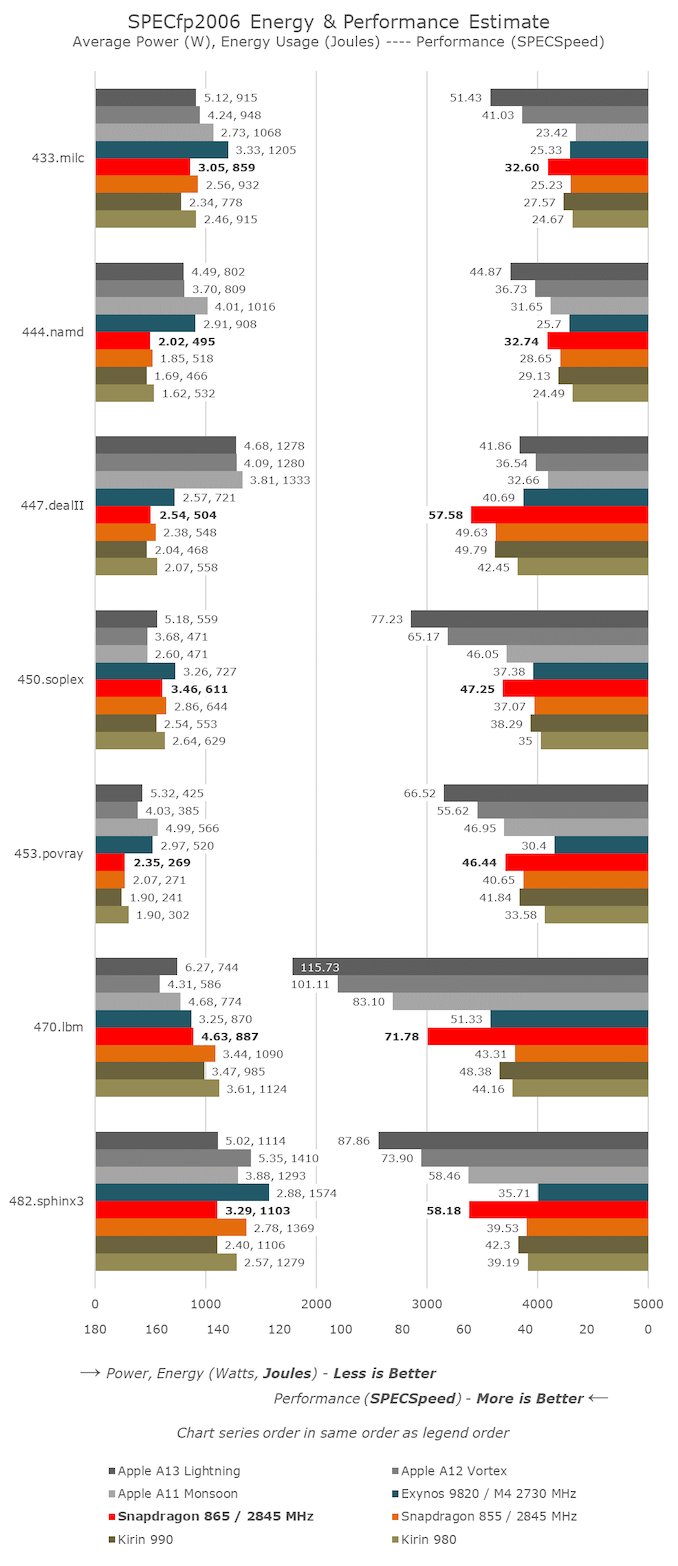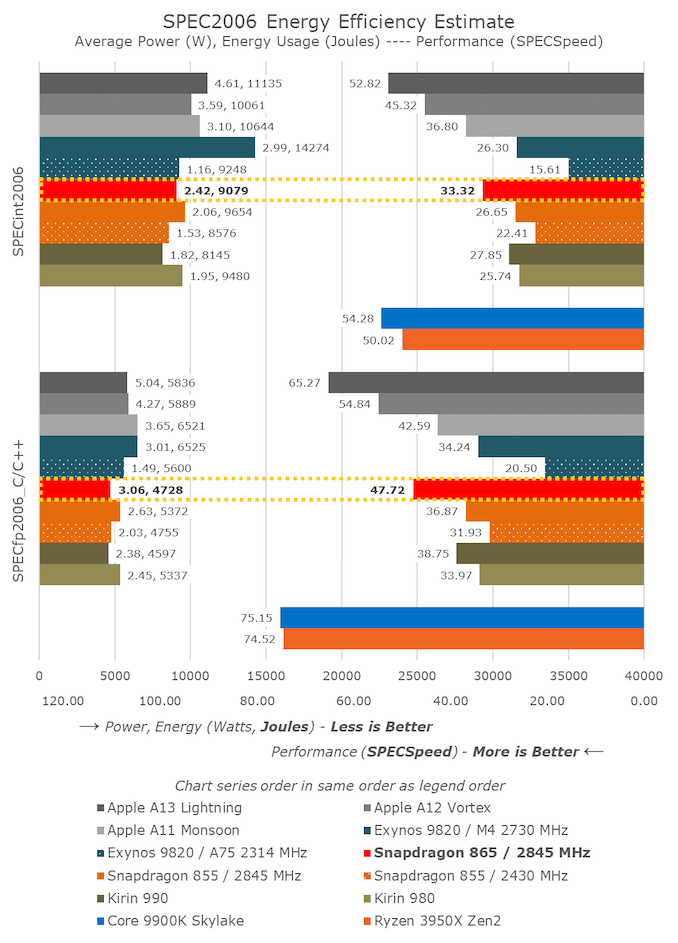The Snapdragon 865 Performance Preview: Setting the Stage for Flagship Android 2020
by Andrei Frumusanu on December 16, 2019 7:30 AM EST- Posted in
- Mobile
- Qualcomm
- Smartphones
- 5G
- Cortex A77
- Snapdragon 865
CPU Performance & Efficiency: SPEC2006
We’re moving on to SPEC2006, analysing the new single-threaded performance of the new Cortex-A77 cores. As the new CPU is running at the same clock as the A76-derived design of the Snapdragon 855, any improvements we’ll be seeing today are likely due to the IPC improvements of the core, the doubled L3 cache, as well as the enhancements to the memory controllers and memory subsystem of the chip.
Disclaimer About Power Figures Today:
The power figures presented today were captured using the same methodology we generally use on commercial devices, however this year we’ve noted a large discrepancy between figures reported by the QRD865’s fuel-gauge and the actual power consumption of the device. Generally, we’ve noted that there’s a discrepancy factor of roughly 3x. We’ve reached out to Qualcomm and they confirmed in a very quick testing that there’s a discrepancy of >2.5x. Furthermore, the QRD865 phones this year again suffered from excessive idle power figures of >1.3W.
I’ve attempted to compensate the data as best I could, however the figures published today are merely preliminary and of lower confidence than usual. For what it’s worth, last year, the QRD855 data was within 5% of the commercial phones’ measurements. We’ll be naturally re-testing everything once we get our hands on final commercial devices.
In the SPECint2006 suite, we’re seeing some noticeable performance improvements across the board, with some benchmarks posting some larger than expected increases. The biggest improvements are seen in the memory intensive workloads. 429.mcf is DRAM latency bound and sees a massive improvement of up to 46% compared to the Snapdragon 855.
What’s interesting to see is that some execution bound benchmarks such as 456.hmmer seeing a 28% upgrade. The A77 has an added 4th ALU which represents a 33% throughput increase in simple integer operations, which I don’t doubt is a major reason for the improvements seen here.
The improvements aren’t across the board, with 400.perlbench in particular seeing even a slight degradation for some reason. 403.gcc also saw a smaller 12% increase – it’s likely these benchmarks are bound by other aspects of the microarchitecture.
The power consumption and energy efficiency, if the numbers are correct, roughly match our expectations of the microarchitecture. Power has gone up with performance, but because of the higher performance and smaller runtime of the workloads, energy usage has remained roughly flat. Actually in several tests it’s actually improved in terms of efficiency when compared to the Snapdragon 855, but we’ll have to wait on commercial devices in order to make some definitive conclusions here.
In the SPECfp2006 suite, we’re seeing also seeing some very varied improvements. The biggest change happened to 470.lbm which has a very big hot loop and is memory bandwidth hungry. I think the A77’s new MOP-cache here would help a lot in regards to the instruction throughput, and the improved memory subsystem makes the massive 65% performance jump possible.
Arm actually had advertised IPC improvements of ~25% and ~35% for the int and FP suite of SPEC2006. On the int side, we’re indeed hitting 25% on the Snapdragon 865, compared to the S855, however on the FP side we’re a bit short as the increase falls in at around 29%. The performance increases here strongly depend on the SoC and particular on the memory subsystem, compared to the Kirin 990’s A76 implementation the increases here are only 20% and 24%, but HiSilicon’s chip also has a stronger memory subsystem which allows it to gain quite more performance over the A76’s in the S855.
The overall results for SPEC2006 are very good for the Snapdragon 865. Performance is exactly where Qualcomm advertised it would land at, and we’re seeing a 25% increase in SPECint2006 and a 29% in SPECfp2006. On the integer side, the A77 still trails Apple’s Monsoon cores in the A11, but the new Arm design now has been able to trounce it in the FP suite. We’re still a bit far away from the microarchitectures catching up to Apple’s latest designs, but if Arm keeps up this 25-30% yearly improvement rate, we should be getting there in a few more iterations.
The power and energy efficiency figures, again, taken with a grain of salt, are also very much in line with expectations. Power has slightly increased with performance this generation, however due to the performance increase, energy efficiency has remained relatively flat, or has even seen a slight improvement.














178 Comments
View All Comments
michael2k - Wednesday, December 18, 2019 - link
I know you want to think that, but the 855 right now barely competes with the A13. The gap may be getting smaller, but when Apple has a multiple year lead in performance, it will take multiple years of iteration to catch up, and that assumes Apple isn't growing either.From the article, the 865 wasn't very competitive with the older A12:
On the integer side, the A77 still trails Apple’s Monsoon cores in the A11, but the new Arm design now has been able to trounce it in the FP suite. We’re still a bit far away from the microarchitectures catching up to Apple’s latest designs, but if Arm keeps up this 25-30% yearly improvement rate, we should be getting there in a few more iterations.
...
The QRD865 really didn’t manage to differentiate itself from the rest of the Android pack even though it was supposed to be roughly 20-25% ahead in theory. I’m not sure what the limitation here is, but the 5-10% increases are well below what we had hoped for. For now, it seems like the performance gap to Apple’s chips remains significant.
...
There’s one apparent issue here when looking at the chart rankings; although there’s an improvement in the peak performance, the end result is that the QRD865 still isn’t able to reach the sustained performance of Apple’s latest A13 phones.
...
Looking at the estimated power draw of the phone, it indeed does look like Qualcomm has been able to sustain the same power levels as the S855, but the improvements in performance and efficiency here aren’t enough to catch up to either the A12 or A13, with Apple being both ahead in terms of performance, power and efficiency.
The 855 was released early this year and was not very competitive with the slightly older A11:
https://www.anandtech.com/show/14031/samsung-galax...
Deboo - Monday, January 27, 2020 - link
Isn't apple cpu cores are arm basedmichael2k - Tuesday, December 17, 2019 - link
The formal term for it is induction.Apple's GPU is very competitive in phones, sometimes taking the top spot, sometimes not:
https://www.anandtech.com/show/13392/the-iphone-xs...
But for their tablets, Apple proceeds to beef up the GPU over 2x the iPhone, in this case by having 75% more CPU cores, much better thermal capacity, and higher clockspeed:
https://www.anandtech.com/show/13661/the-2018-appl...
It is beaten by the GTX 1060, but beats the Ryzen 7, in PC space, and soundly beats the iPhone by 80% when not CPU bound.
So the inductive part is that, given the 865 approaches the performance of an iPhone, it won't approach the performance of an iPad.
id4andrei - Tuesday, December 17, 2019 - link
One thing to remember when you compare GPUs. Benchmarks usually run half precision operations on mobile compared to what they run on desktop - FP16 vs FP32. Also on ios they run Metal while on Windows DX12 or Vulkan or OpenGL. Not the same thing.IUU - Thursday, December 26, 2019 - link
Apple cores beating the ryzen 7 is a very big word and requires a big leap of faithph00ny - Monday, December 16, 2019 - link
Probably. Android tablet is pretty dead and there is no real solid demand for a "faster" hardwaregeneralako - Monday, December 16, 2019 - link
That's a stupid exaggeration. If it were dead how come Huawei just released the Mediapad M6 this summer with Kirin 980, and is currently releasing an even more premium tablet right now? How come Samsung makes a new Tab S every year, along with iterations of cheaper models every now and then? Same with Xiaomi, Lenovo and others. Low-end market is sprawling with new tablets from all sorts of brands. Even LG released a tablet this year. The tablet market may not be huge, and certainly lackluster in a lot of ways on Android (mainly due to Google neglecting it since Nexus 9 was a flop; you don’t follow-up Nexus 7 v2—the best tablet ever made—with that nonsense), but it very much exists and is desired by a lot of customers. This reality is true for Apple too, that waited 4-5 years before it released a new iPad Mini iteration.As an avid tablet user myself, even with a lot to be desired on Android, I still very much like many offerings by them the past 2 years. I'm currently using both an iPad Mini 5 and Mediapad M6 8.4”. Seeing as I, like most other people, use tablett for media consumption (YouTube, streaming movies/shows, reading books, Reddit, browsing, Spotify), the available supported apps are equally good for both platforms. If I were to dive deeper to dedicated application, sure, iPad has much better support, I really never do as I use a tablet for the specific uses it was made for. I can see this be a complaint if you're an iPad Pro user and use it for professional work, but I don't really see that being a desire for even those using regular iPad or iPad Mini. Maybe if you’re a gamer, but that’s really it.
I use the Huawei more than the iPad Mini due to how much more intuitive Android is. At the end of the day, they both run oversized variants of their smartphone OS, and Android is simply more intuitive in a lot of respects, with iOS use still feeling like having one hand behind my back. Where Apple is fantastic though, is in its hardware implementation, like its excellent screen calibration and touch latency, or having a 3.5mm input (unlike M6 or newer Tab S, sadly) with really good DAC that properly drives my HD650. Mediapad wins in more effective and ease-of-use OS, 16:10 aspect ratio. Android also makes it easier to do things like torrenting (which is great for downloading/streaming movies, football matches, etc.), local file management and sharing and more. Ironically, Apple has made up for the Mediapad’s lack of jack with its fantastic 3.5mm Type-C for $7, which beats DACs upwards of 10x its price (no joke – Apple really knocked it out of the park).
imaheadcase - Tuesday, December 17, 2019 - link
Let alone the thousands of Samsung tablets with android that sell like hot cakes. Given the sell over holidays on them, they are even more attractive.Sure Samsung is terrible at updating software, but not a deal breaker by any means, i tried parents Ipad and it just felt wrong using it, i can't quite put finger on reason, just seems so limited with apps and just not responsive.
Things just work great on Android variant for me.
Oliseo - Thursday, December 19, 2019 - link
One look at Android App Stores tells you just how successful Android Tablets are. That's something everyone can do, and not just take some random fanboys drivel on a forum./end debate
Lois - Friday, December 27, 2019 - link
This is just your feeling and not a fact… Some people feel better on iPadOS and some others on Android. Now the fact is that iPad is more powerfull than andoid Tablets…